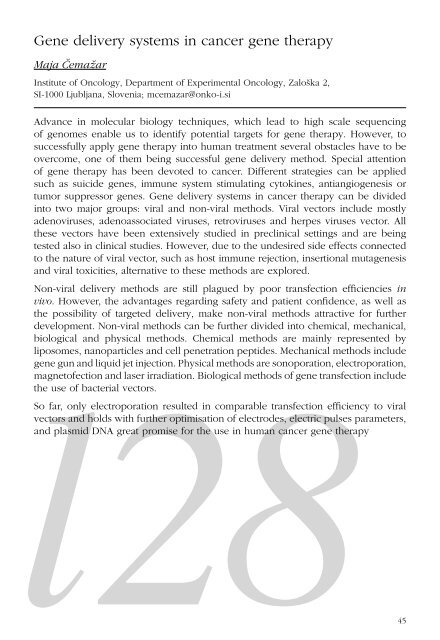Create successful ePaper yourself
Turn your PDF publications into a flip-book with our unique Google optimized e-Paper software.
Gene delivery systems in cancer gene therapy<br />
Maja ^ema`ar<br />
Institute of Oncology, Department of Experimental Oncology, Zalo{ka 2,<br />
SI-1000 Ljubljana, Slovenia; mcemazar@onko-i.si<br />
Advance in molecular biology techniques, which lead to high scale sequencing<br />
of genomes enable us to identify potential targets for gene therapy. However, to<br />
successfully apply gene therapy into human treatment several obstacles have to be<br />
overcome, one of them being successful gene delivery method. Special attention<br />
of gene therapy has been devoted to cancer. Different strategies can be applied<br />
such as suicide genes, immune system stimulating cytokines, antiangiogenesis or<br />
tumor suppressor genes. Gene delivery systems in cancer therapy can be divided<br />
into two major groups: viral and non-viral methods. Viral vectors include mostly<br />
adenoviruses, adenoassociated viruses, retroviruses and herpes viruses vector. All<br />
these vectors have been extensively studied in preclinical settings and are being<br />
tested also in clinical studies. However, due to the undesired side effects connected<br />
to the nature of viral vector, such as host immune rejection, insertional mutagenesis<br />
and viral toxicities, alternative to these methods are explored.<br />
Non-viral delivery methods are still plagued by poor transfection efficiencies in<br />
vivo. However, the advantages regarding safety and patient confidence, as well as<br />
the possibility of targeted delivery, make non-viral methods attractive for further<br />
development. Non-viral methods can be further divided into chemical, mechanical,<br />
biological and physical methods. Chemical methods are mainly represented by<br />
liposomes, nanoparticles and cell penetration peptides. Mechanical methods include<br />
gene gun and liquid jet injection. Physical methods are sonoporation, electroporation,<br />
magnetofection and laser irradiation. Biological methods of gene transfection include<br />
the use of bacterial vectors.<br />
l28<br />
45<br />
So far, only electroporation resulted in comparable transfection efficiency to viral<br />
vectors and holds with further optimisation of electrodes, electric pulses parameters,<br />
and plasmid DNA great promise for the use in human cancer gene therapy

















